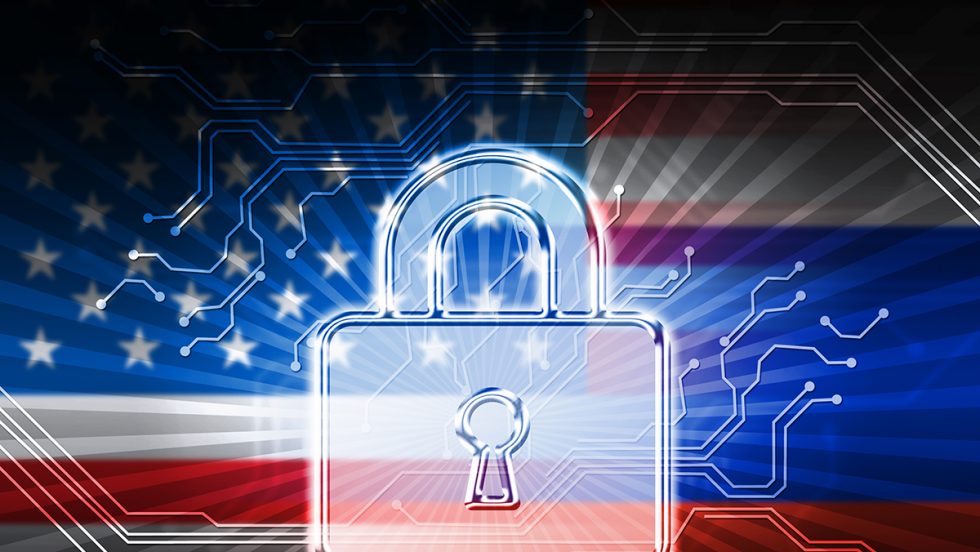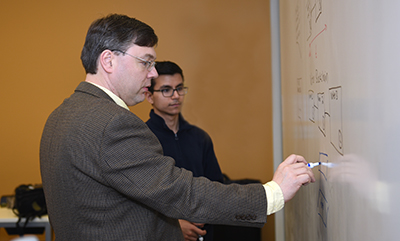
A new dual-blockchain architecture promises to enhance election transparency, security and equity.

Computer science professor Kees Leune, PhD and student at whiteboard.
For a democracy to function, public faith in elections is critical. Voters must believe that all votes are counted fairly, yielding a legitimate victor. But the aftermath of the 2020 presidential election shows that many Americans question the security of our voting systems.
Kees Leune, PhD, assistant professor of mathematics and computer science at Adelphi, believes that doubts about election security can be attributed in part to the limitations of commonly used voting machines. “When you put things in computers, transparency is harder because people don’t understand—or trust—computers,” he said.
To address this skepticism, Dr. Leune partnered with Honors College alumnus Jai Punjwani ’18, now a software engineer at Bloomberg, to develop new technology that could make electronic voting both more transparent and more secure. The secret? Blockchain technology. The two shared their research in the article “Enhancing Electronic Voting With A Dual-Blockchain Architecture,” which appeared in the cryptocurrency journal Ledger in February 2021.1
According to the authors, blockchain is ideal for electronic voting systems because it offers security without a central authority. “You can think of blockchain as a large ledger, a book of transactions that cannot be manipulated,” Dr. Leune explained. “Once something is written down on a blockchain, any tampering with that data will fail, which makes it an immutable electronic ledger. Blockchain uses all kinds of cryptography to prove that messages have not been tampered with. It is 100 percent secure.”
Because many skeptics of election integrity are suspicious of the organizations and institutions that run and verify elections, blockchain’s second improvement on existing technology is crucial: Blockchain does not have to be centrally managed. “There is no central agency that checks all the data on the blockchain,” Dr. Leune said. “In our system, the process of validating the results can be made public and shared with independent auditors.” In theory, then, each citizen could individually verify the results of the election. The system also offers independent auditors the ability to validate results without compromising voter secrecy, accomplished through the use of two discrete blockchain ledgers. “One blockchain records the fact that you have voted. The second blockchain records the vote itself. Those are kept separate, so it would be impossible to see who voted for whom.”
Although independent auditing can validate the results after the election has concluded, Dr. Leune and Punjwani’s “consensus algorithm” prevents fraud from occurring in the first place. “The consensus algorithm is the process by which all the machines involved determine that each part of the voting process is done properly,” Dr. Leune said. “When I cast a ballot, the consensus algorithm will make sure I have filled it out correctly. For instance, did I select too many candidates? Only if all criteria are met will the algorithm allow a vote to be recorded on the second blockchain. And if I try to vote a second time in a different location, the consensus algorithm will see the entry on the first blockchain that says I have already voted.”
As promising as a blockchain-based voting system appears, however, Dr. Leune cautioned that no technological innovation can serve as a panacea. “Any system exclusively on an electronic record is likely to fail,” he stressed. “There should always be a paper trail somewhere so that results can be verified.” Even so, he hopes to improve upon his prototype with further research and innovations, in part by revisiting its assumptions.
“Jai and I assumed that we can always unambiguously identify the person who is trying to vote, but obviously that’s not always the case at polling places,” he said. “We also assumed this technology could only be used in machines at polling places, but we’d like to be able to improve accessibility. Someday, perhaps anyone with a computer will be able to vote anywhere in the world.”
1 Leune, Kees, and Jai Punjwani. “Enhancing Electronic Voting With A Dual-Blockchain Architecture.” Ledger, vol. 6, 10 February 2021.